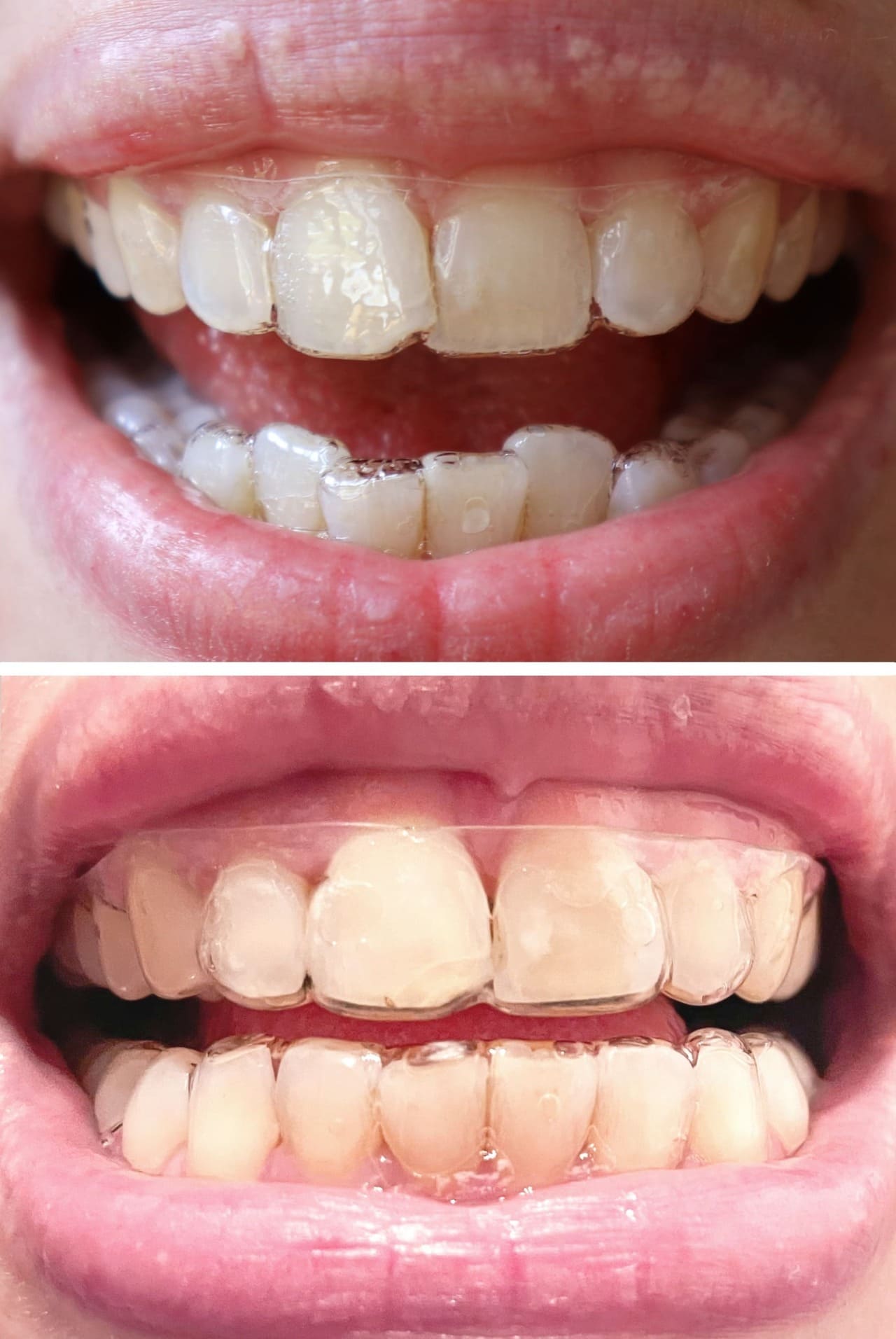To achieve the ideal results, trays must be worn 20-22 hours/day. Aligners are no magic therapy and since they are removable, they require more effort on your behalf. Braces deliver consistent force for 24 hours a day, but with aligners, we require at least 20 hours of wear a day to achieve these similar results. The metaphor I use most often is that tooth movement is like pushing a ball up a hill. If you only do it for a little bit and let go, the ball will roll down the hill, however, if you wear it as prescribed, you will achieve ideal results.
What are Invisible Braces and how do they work?
Invisible braces (or clear aligners) are a type of orthodontic appliance that are used to straighten teeth and correct misalignment. They are made of a clear, flexible plastic material that is custom-fit to the shape of the teeth. The aligners are worn over the teeth and apply gentle pressure to move the teeth into the desired position.
Invisible braces apply a gentle, continuous force to the teeth, causing the ligaments to stretch and the bone around the tooth to remodel. Teeth are held in place by the bones of the jaw and are connected to the bones by ligaments. When a force is applied to a tooth, it causes the ligaments to stretch, which triggers the cells in the bone around the tooth to break down and new cells to form. This process, called bone remodeling, allows the tooth to move in the direction of the applied force. As the bone around the tooth is broken down and new bone is formed, the tooth is gradually moved into the desired position.
Invisible braces work by using a series of progressively more refined aligners, each of which is worn for about two weeks before being replaced with the next in the series.
The amount of movement that can be achieved with invisible braces depends on the severity of the misalignment and the specific movements that need to be made. In some cases, invisible braces can be used to correct mild to moderate misalignment, while in other cases, more complex movements may require additional treatment.

There are many benefits of invisible braces over traditional braces.
- First, invisible braces are nearly invisible, so they are much less noticeable than metal braces.
- Second, invisible braces can be removed for eating and brushing, so you can eat whatever you want and maintain good oral hygiene.
- Third, invisible braces are more comfortable than braces, so you can wear them for longer periods of time without discomfort.
- Fourth, invisible braces can be customized to your specific dental situation, so you can get the best results possible.
- Finally, invisible braces are more affordable than braces, so you can save money while still getting the smile you want.
Invisible braces may not be suitable for everyone.
Severe misalignment:
Missing teeth:
If a person has missing teeth, clear aligners may not be able to properly align the remaining teeth. Alternative treatment options, such as dental implants or fixed bridges, may be necessary to replace missing teeth.
Underbite or overbite:
Invisible braces are not typically effective for correcting underbites or overbites, which are more complex issues that require more extensive treatment. Alternative treatment options, such as traditional braces or jaw surgery, may be necessary to correct these issues.
Severely rotated teeth:
Invisible braces may not be able to effectively correct severely rotated teeth. In these cases, traditional braces or other orthodontic appliances may be more effective.
The biggest problem with aligners is:
It doesn't work if you don't wear them. So if you are not a compliant person aligners are not for you. You have to be very, very disciplined. If you can't wear them 20 hours a day, it is not going to work.
How long does it take?
Treatment Procedure
The dentist takes impressions of your teeth, and sends them to a company that produces invisible braces (aligners). The company cleans The dental impressions and digitally scans them with the aid of the virtual model, the malocclusion, is corrected on the monitor. Afterwards, the resulting digital data is transferred to plastic models by means of which the corresponding splints are produced, depending on the initial findings anywhere between 12 and 50 split are generally required for treatment.
The aligners must be worn, 22 hours a day and are usually changed within a period of two weeks, so that the teeth are gradually straightened in steps of 0.15 to 0.25 millimeters per aligner until they reach their final position as specified by the orthodontist. The extent of movement depends on several factors, including the type of tooth movement, as well as on periodontal conditions. As a general rule of thumb, the patient receives two new splints per jaw at each short monthly appointment.
On the first day, a majority of patients experience slight pressure or sensitivity of the teeth where new aligners are placed. This demonstrates that the aligners are effective and that the teeth are moving into the desired position. Thanks to the transparent splints, the TC position is corrected in an almost invisible fashion. Furthermore, the patient is able to remove the device and eat and drink whatever he wishes, plus care for his teeth as usual throughout the treatment course, thus employing optimal oral hygiene.

"...things I want patients to be aware of before beginning any clear aligner orthodontic therapy..."
Trays must be worn 20-22 hours per day
Aligner therapy will usually require temporary attachments to be placed on the teeth.
As the teeth are very smooth and hard to get a grip of to move, we typically bond attachments onto the teeth that allow for them to be gripped by the aligner. Attachments are made from filling material that are added to the front side of the tooth and are removed after treatment is completed. They serve as handle bars and ensure that the movement planned by the orthodontist is achieved by the aligners.
Aligner therapy may require interproximal reduction (IPR)
IPR aims to slim down teeth by removing a small bit of tooth structure between the teeth. This allows for us to have more room to have teeth fit into the arch, or to optimize the overall anatomy of the teeth. Generally, your front teeth are fan-shaped and what IPR does is remove the tips of these fans to allow for them to fit together better. Generally, the procedure is painless but may cause some slight sensitivity afterwards.
Aligner therapy may require you to still wear rubber bands to fix your bite
Aligners work quite well to make your upper teeth and lower teeth straight, but what they can't do, nor braces can do, without your help, is to fix your bite. You and your orthodontist can work together to align your individual arches but with the use of prescribed rubber bands, it can help your upper and lower teeth to coordinate and fit together and make, not only a excellent smile, but a perfect bite.
Most of the time, with aligners, we will require a mid-course revision/refinement
Most aligners will provide you with a final tray #, such as "tray 3 of 15," however it may require more than 15 trays to complete your treatment. The first set of trays will definitely get you close to being done, however, generally a mid-course refinement is necessary to ensure you have the best results possible! This does not mean that your or your orthodontist did anything wrong, but rather is used to assess how well your teeth are following along with the trays and perfecting the small details.
Dental Clinics Near You
Book a Dental Treatment
Our Smylor dental marketplace allows you to review and request bookings from 100s of dentists near you. Currently available in Switzerland (Zürich & Zug) and Germany (Köln, Düsseldorf and Bonn).
Click on your region.


